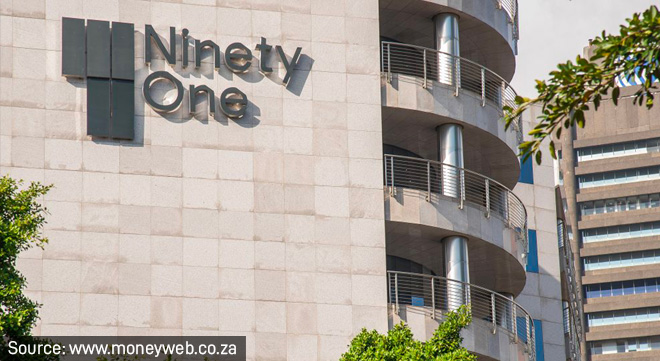Ninety One, the global asset manager listed on the London Stock Exchange and the Johannesburg Stock Exchange, grew its assets under management (AUM) by 4% to £130.8 billion (R3.15 trillion) despite a challenging market environment in the year to the end of March 2025.
The increase in AUM was driven by positive market and foreign exchange movements of £9.7bn, which offset net outflows of £4.9bn. The net outflows marked a significant improvement from the £9.4bn recorded in the previous year.
Ninety One chairman Gareth Penny and chief executive Hendrik du Toit said in the asset manager’s integrated report that the reporting period was another tough year. “Business conditions were challenging, but green shoots started to appear in the second half.”
They said Ninety One’s 2025 financial results escaped the impact of US President Donald Trump’s “Liberation Day” tariffs on 2 April, which heightened volatility.
Penny and Du Toit said the year was characterised by two distinct halves. The first half saw net outflows of £5.3bn because of persistent risk aversion towards public markets and emerging assets, as clients rebalanced portfolios and reduced cyclical exposures. However, the second half reflected a turnaround, with net inflows of £0.4bn.
Equities were the biggest source of net outflows, mainly in global and sustainable equity strategies. Despite this, some equity strategies such as emerging markets, international, and core global equities recorded positive net flows.
Fixed income and multi-asset strategies also saw net redemptions.
Alternatives bucked the trend with net inflows of £637 million, driven by demand for credit strategies.
The South African fund platform generated net inflows of £359m, reflecting strong engagement with independent financial advisers in the region.
From a geographical perspective, the UK client group was the largest contributor (£3.9bn) to overall net outflows. This was driven by a combination of portfolio rebalancing and reduced allocations to some equity strategies.
Within the Americas client group, net outflows (£701m for the full year) were largely due to client restructurings, but there was a return to net inflows from Latin American institutional clients compared with the prior year.
In the remaining client groups, there were swings from net outflows in the first half to net inflows in the second half. For the Africa client group (with full year net outflows of £289m), the second half saw some sizeable client wins into global equities, multi-asset and alternatives strategies.
The Asia Pacific client group (£738m full-year net inflows) saw increased demand for global and Asian equities, while the Europe client group (with £716m full-year net outflows) experienced a positive second half, driven by fixed income and European and Asian equity strategies.
Institutional net outflows of £1.7bn were a material improvement from the previous year and turned positive in the second half. The advisor channel recorded £3.1bn in net outflows, mainly from equity and multi-asset strategies.
“Overall, client activity improved steadily throughout the year. The inflection in flows mid-year supports our belief that clients are beginning to re-risk selectively and that demand is returning for differentiated active strategies. Nevertheless, competition for client capital is as intense as ever,” Penny and Du Toit said.
Financial performance
Ninety One’s financial performance reflected the mixed flow dynamics and market conditions.
Management fees increased by 2%, despite a 1 basis point reduction in the average management fee rate, thanks to a 4% rise in average AUM to £129bn. Adjusted operating expenses also increased by 2%, demonstrating ongoing cost discipline.
However, a slight decline in performance fees contributed to a 1% decrease in adjusted operating profit to £187.9m, down from £190.5m in 2024. The adjusted operating profit margin fell to 31.2% from 32% in the prior year. Additionally, higher corporation taxes led to a 3% decrease in adjusted earnings per share.
The board has recommended a final dividend of 6.8 pence per share, up from 6.4 pence in 2024, bringing the full-year dividend to 12.2 pence per share (compared to 12.3 pence in 2024). This aligns with the company’s policy of paying out at least 50% of profit after tax, plus any excess earnings not required for investment or regulatory purposes.
Investment performance
Ninety One’s investment performance improved across all major time horizons. As of 31 March 2025:
- 68% of AUM outperformed their respective benchmarks over one year.
- 59% outperformed over three years.
- 72% outperformed over five years.
- 81% outperformed over 10 years.
- 76% of AUM outperformed since inception.
Partnership with Sanlam
In November 2024, Ninety One entered a strategic relationship with Sanlam, the largest non-banking financial services group in Africa.
Under the agreement, Ninety One will become Sanlam’s primary active investment manager, gaining access to Sanlam’s extensive retail distribution network in South Africa. Additionally, Sanlam will serve as an anchor investor in Ninety One’s international private and specialist credit investment strategies that meet its requirements.
Shareholders approved the issuance of shares related to the transaction in April 2025, and the deal is now awaiting final regulatory approvals.
Outlook
Looking ahead, Ninety One expressed cautious optimism for the new financial year. Moderating inflation and easing interest rates have contributed to broadening market participation and normalising risk appetite.
However, the company remains mindful of ongoing risks, including global political uncertainty, market volatility, and evolving regulatory landscapes.
Ninety One said it will focus on scaling its strongest investment strategies, deepening relationships in priority markets, and modernising operations through technology integration. The firm emphasized its commitment to disciplined, long-term execution and its conviction in the future of active management.




